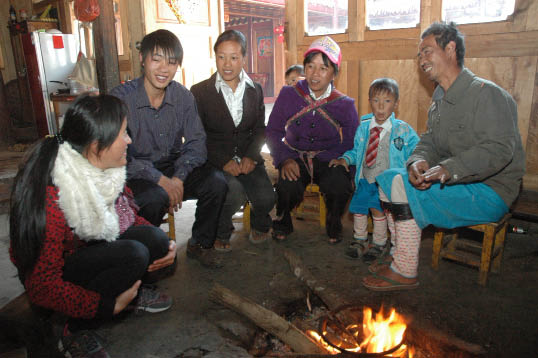|
Life on the China-Myanmar Border
By stuff reporters TANG SHUBIAO & LI GUOWEN
THE scent of fresh tsaoko fruits filled the spacious home of 47-year-old Yu Fuyan, a farmer in Yujiazhai Village, Yunnan Province. Ignoring their spicy aroma, one could easily mistake them for red dates. All the tsaoko fruits would be sold to purchasers who would take them away from the village for processing, Yu said.
Yujiazhai, a community of Lisu minority, is located just a few kilometers away from the China-Myanmar border and has around 5,000 residents. Here, locals are still largely self-sufficient, and much of their land is dedicated to growing the cash crop tsaoko.
 |
| Liu Zufang (first left), head of the Cultural Center of Houqiao Town, visits Yu Fuyun's family. |
Turning Tsaoko into Cash
October 30 is an important day for Yujiazhai, as the whole village sets about harvesting their main crop. Purchasers send trucks to the village to buy up the farmers' heaps of tsaoko — a small, reddish-brown fruit used as a seasoning and in traditional Chinese medicine which only grows in rainforests and tropical regions. They buy the fruits at around RMB 7 per kilo. The Yus' annual 10-ton yield can bring them an income of about RMB 70,000.
Although tsaoko has long been a traditional crop in the area, the current scale of planting has only developed in recent years. A decade ago, the township government began to guide local farmers in stepping up production, and found purchasers for the fruit. This is part of the national drive to boost farmers' income by encouraging underwood plantation in rural areas with appropriate conditions.
Growing on the Yus' seven hectares of wooded land, tsaoko has become the family's main source of cash. The four family members are not alone in this; Yujiazhai and its neighboring Caijiazhai Village grow more than 383 hectares of this spice.
The Yus also earn extra income from the 14-plus hectares of Chinese firs that grow on their farm. Most of these have been planted in the last few years, and have yet to reach maturity. The family occasionally fell the older trees, and sell their timber.
The rest of the farm is taken up with crops and pigs for their own consumption. The Yus grow maize, which they use to feed their pigs, and buckwheat and vegetables, which they eat themselves. Their staple grain, however, is rice, which they buy, along with daily necessities, from the township 20 km away. Like other families in the village, the Yus make three shopping trips a month.
The Yus raise four pigs, two of which are still piglets. "A pig usually needs one year to one and half years to grow to full size ready for slaughtering," said Yu Fuyan. The meat is then smoked or salted so that it can be stored.
The villagers' self-sufficiency extends to the very houses they live in, which they usually build themselves. These homes were mostly made from wood and clay in the past, but nowadays, though the main structure is still wood, bricks are incorporated into the buildings.
| 